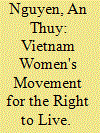| Srl | Item |
| 1 |
ID:
142504


|
|
|
|
|
| Summary/Abstract |
This article looks at two contemporary films by Vietnamese women. In Việt Linh's Travelling Circus (1988) and Phạm Nhuệ Giang's The Deserted Valley (2002), a female gaze is sutured to that of an ethnic minority character's, a form of looking that stresses a shared oppression between women and the ethnic Other. While clearing a space for a desiring female gaze in Vietnamese film, they nonetheless extend an Orientalist view of racialised difference. A feminist film optic, one that does not consider industry history and constructions of race, fails to mark out the layered relations of looking underlying Vietnamese filmmaking. This study attends to the ways women filmmakers investigate gendered forms of looking, sexual desire and otherness within the constraints of a highly male-dominated film industry.
|
|
|
|
|
|
|
|
|
|
|
|
|
|
|
|
| 2 |
ID:
163346


|
|
|
|
|
| Summary/Abstract |
This article examines the political and diplomatic struggles in urban South Vietnam from the perspective of women in the Vietnamese Women’s Movement for the Right to Live (WRL) during the Vietnam War. This movement was a timely response to the American war of aggression, which had destroyed the fabric of South Vietnamese society and drastically diminished women’s position within it by 1970. Under the leadership of Mrs. Ngô Bá Thành, the WRL fought for peace and women’s liberation through political action and shrewd diplomacy. Unlike female guerrilla fighters, the WRL maintained political autonomy and neutrality throughout the conflict. As a result, it was violently repressed by the Saigon government and quickly disbanded after the communist victory in 1975. Nevertheless, studying these politically sophisticated women’s anti-war efforts is crucial to understanding the symbiotic yet destructive relationship between Third World women and American imperialism during the twentieth century. It also helps dismantle essentialist assumptions about Asian women as inherently submissive and politically naïve. The WRL is a sterling example of Vietnamese women’s ingenuity in their dual struggle for national liberation and gender equality.
|
|
|
|
|
|
|
|
|
|
|
|
|
|
|
|